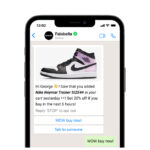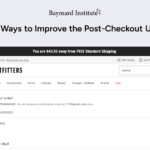As consumers’ omnichannel shopping habits rapidly evolve, retailers and brands are finding shoppable content, such as interactive ads and streaming, could go a long way toward driving conversion.
Online merchants are faced with the challenge of preventing customer drop-off at each stage the buying journey. The friction points leading to cart abandonment — a complicated page navigation experience, unclear checkout processes, redirection to external pages — are mitigated when brands and retailers can offer seamlessly integrated purchasing options.
The PYMNTS Intelligence report “How Preferred Payment Availability Can Reduce Cart Abandonment,” which drew from a survey of more than 3,500 U.S. consumers, found that shoppers abandoned shopping carts on brands’ sites an average of eight times in the last 30 days and six times on retailers’ sites.
By minimizing the steps required to make a purchase, merchants can reduce the likelihood of abandoned carts and propelling conversion rates. Shoppable content is emerging as a more frictionless solution, offering an intuitive and direct path to purchase.
TVs Become eCommerce Platforms
Streaming services are aiming to seize on this opportunity with shoppable TV, blending the realms of advertising and immediate consumer action. With companies like Disney, Amazon and Roku pioneering in this space, the integration of shoppable ads into streaming content is becoming a reality, reducing the steps between product discovery and purchasing.
Earlier this year, Disney introduced its Gateway Shop ad format, leveraging the ubiquitous presence of second screens to engage viewers with personalized product prompts sent directly to their phone via push notification. This approach is indicative of the broader industry movement toward creating more engaging, interactive, and frictionless shopping experiences across all media platforms.
Consumers are at least somewhat open to these kinds of experiences. PYMNTS Intelligence’s “How We Will Pay Report: How Connected Devices Enable Multitasking Among Digital-First Consumers” found 1 in 3 connected device owners would be interested in being able to buy clothing or jewelry that they see on actors in a given film or series directly from the streaming platform. Plus, 5% of consumers who own or have in their home at least one connected device reported that they already do this.
The Social Commerce Opportunity
Additionally, social media giants such as TikTok and Meta have become battlegrounds for the dominance of shoppable content. The former has reportedly been testing a feature to make all videos on the app shoppable, and the latter has been integrating Amazon shopping into its Facebook and Instagram platforms.
Granted, social commerce has a ways to go. The PYMNTS Intelligence report “Tracking the Digital Payments Takeover: Monetizing Social Media,” created in collaboration with Amazon Web Services, found that 43% of consumers browse social media to find goods and services. However, only 14% ultimately purchase those goods and services via social media.
The landscape of retail is undergoing a transformation, with shoppable content playing a prominent role in bridging the gap between brand awareness and direct consumer action. The emphasis on reducing friction and enhancing the shopping experience reflects a broader trend towards more personalized, engaging, and intuitive retail interactions.
As brands and retailers navigate these changes, the adoption of shoppable ads and the exploration of new platforms such as shoppable TV are not just trends but essential strategies for achieving growth and maintaining relevance in the digital age.
Brands can leverage these evolving media trends to connect with consumers in more meaningful ways, driving sales and fostering loyalty in a rapidly changing retail environment.






